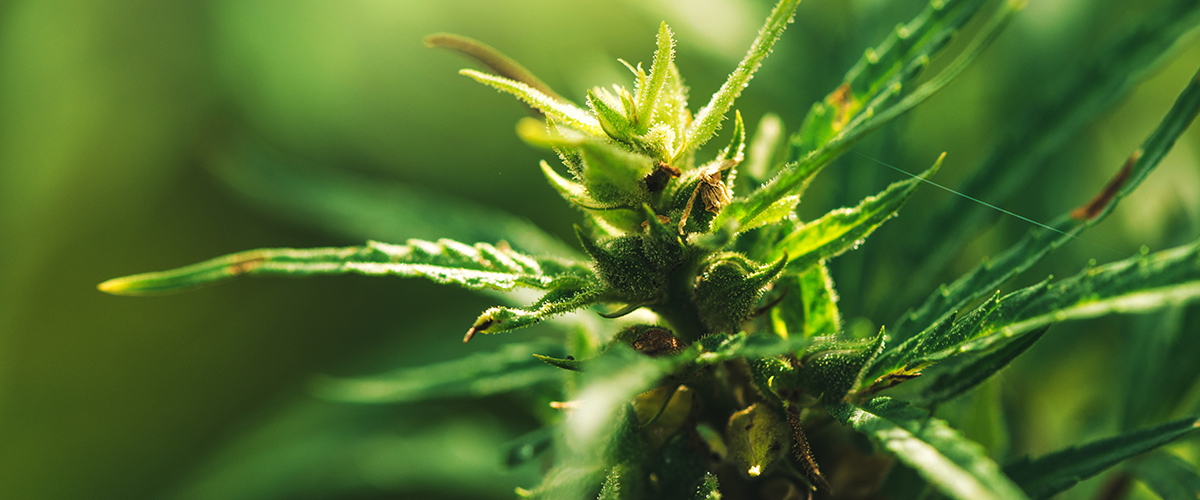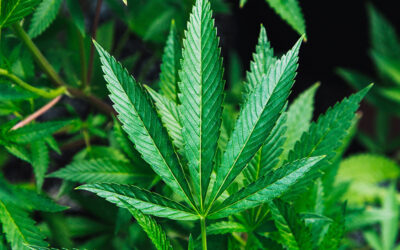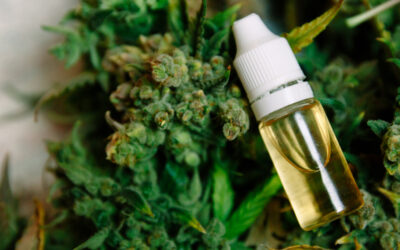Marijuana strains are classified as autoflowering when they aren’t reliant on light cycles to flower. Here we dive into autoflowering strains, the advantages autoflowering offers growers, and whether the characteristics of autoflowering strains meet your needs.
If you’re looking into growing your own medical marijuana at home, it’s likely you’ll notice some strains of seeds described as “autoflowering.” Before making any purchases, you’ll want to know what it means when a variety of cannabis is autoflowering and whether it’s the right type of marijuana strain for you and your garden. But first, let’s answer the question: what is autoflowering?
What is Autoflowering?
Autoflowering strains of marijuana automatically transition from the vegetative stage to the flowering stage on their own with age, regardless of whether there’s a change in the ratio of light to dark hours.
The flowering stage is the final phase in cannabis cultivation, when the plant becomes fully mature and produces usable cannabis flower. In autoflowering strains, this switch to the flowering stage automatically happens without any outside stimulus as fast as within 2 to 4 weeks of germination for some strains.
Autoflowering is a process that is relatively unique and rare. It’s created when marijuana breeders growing the widely used Cannabis indica or sativa strains incorporate the genetics from Cannabis ruderalis.
Pure indica and sativa strains rely on photoperiods – changes in the ratio of light and dark periods they’re exposed to – in order to flower, while ruderalis strains often do not.
Cannabis ruderalis is a subspecies of cannabis plant first identified in the 1920’s. It’s naturally shorter in stature, contains a lower concentration of tetrahydrocannabinol (THC), and has autoflowering attributes.
By cross breeding ruderalis strains with indica or sativa varieties to bring out autoflowering characteristics, the new marijuana strain flowers on its own time without relying on photoperiods.
Differences Between Autoflowering and Photoperiod Marijuana Strains
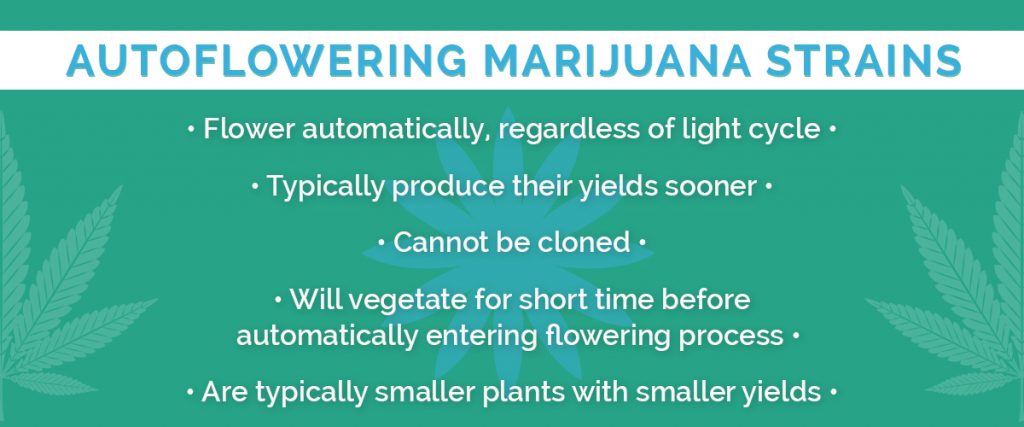
Need for Specific Light Cycle
Most strains of marijuana are known as “photoperiod” strains. Photoperiod cannabis plants will not transition into the flowering phase and begin making buds until they’re exposed to a specific light-to-dark ratio.
These more traditional strains naturally produce flowers during the late summer, fall, or in some regions, into winter, so the amount of light and dark they receive should reflect the changing season and shortening of days. Most growers trigger the flowering process in photoperiod marijuana plants by shortening their light cycles to an even 12 hours of light and 12 hours of dark each day.
What makes autoflowering marijuana strains different? Autoflowering cannabis strains will begin producing flowers once they reach 4 weeks or so, no matter what’s going on with light and dark schedules.
If you’re growing your own marijuana, this also means you can have multiple autoflowering plants growing at different stages without having to worry about specific lighting needs for each plant. Autoflowering plants can also be more easily grown outside since you don’t have to worry about the time of year you plant or harvest your cannabis plants.
Length of Growth Cycle
Autoflowering marijuana plants are typically ready for harvest sooner than photoperiod plants, off setting their generally low yield. This is especially helpful for indoor growers looking to maximize the number of harvests they get in a year. Though skillful outdoor growers in the right climates can potentially take in multiple harvests in a single growing season.
The flowers of most autoflowering plants are ready to be harvested 2 to 3 months after they’ve sprouted from seed. This is because the vegetative stage of autoflowering plants is shorter, lasting for just a few weeks.
Photoperiod plants generally take 3 to 4 months or longer after sprouting from seed before they’re ready to harvest, depending on location. Part of this is because photoperiod plants require a longer vegetative stage before they begin flowering.
Size of Yield
Photoperiod strains typically produce greater yields of flower compared to autoflowering strains, although the yield of photoperiod plants can vary significantly depending on the specific strain and growing techniques.
Autoflowering strains, which tend to stay short naturally, generally yield up to about 4 ounces of usable marijuana flower per plant, but most growers end up yielding about 1 to 2 ounces. With that said, an advantage of the short lifespan of autoflowering plants is that growers can produce multiple harvests a year.
Ability to be Cloned
Photoperiod marijuana strains can be cloned, which means a grower take a cutting from the plant and grow more plants from a single seed. Autoflowering strains, however, cannot be cloned effectively.
This is because the clones of autoflowering plants, which live short lives, are on the same internal “time clock” as their parent. As a result, autoflowering clones will only live as long as the original plant lives – not long enough to produce their own yields. For this reason, autoflower strains are available in seeds only.
Are Autoflowering Marijuana Strains Good for Users?
Generally, autoflowering Cannabis ruderalis strains wouldn’t be ideal for recreational and medical marijuana use because they produce flowers that are low in THC, the intoxicating psychoactive compound that is also beneficial to many medical marijuana consumers.
Today, however, most autoflowering marijuana strains do produce bigger flowers that are comparable in THC potency to traditional photoperiod strains. This is because over the years breeders have intermingled these low THC ruderalis plants with indica and sativa strains that are larger and contain more significant THC concentrations.
Cannabinoids, like THC and CBD, when consumed interact with the body’s endocannabinoid system, a signaling network that is continuously working to keep many functions in balance.
Autoflowering plants also tend to have higher amounts of cannabidiol (CBD), the non-psychoactive cannabinoid that’s been highly sought after in recent years.
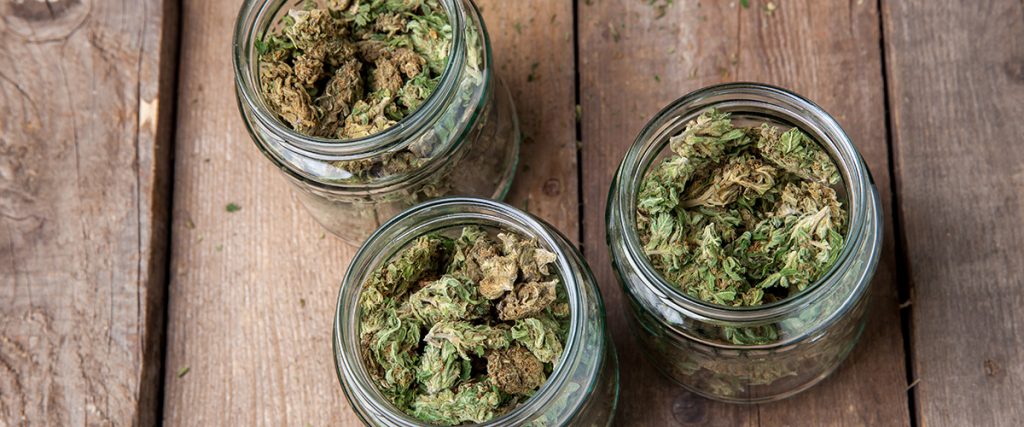
Popular Autoflowering Marijuana Strains
Interested in trying out autoflowering plants? Marijuana breeders incorporate the autoflowering genetics and shortened overall growing period from Cannabis ruderalis in an effort to make things easier for home cannabis growers.
Autoflowering cannabis seeds may be available at your local dispensary, but your best bet is to look for them at retail and online seed banks.
Here’s a look at three of the most popular autoflowering marijuana strains:
- Northern Light Automatic
Mixed with primarily indica cannabis and a little sativa, the Northern Light Automatic marijuana strain is particularly abundant in CBD. This strain is said to produce a succulent and sweet flavored flower.
- Amnesia Haze Automatic
As a descendent of nearly entirely sativa, the Amnesia Haze Automatic strain contains high levels of THC and therefore requires a slightly longer flowering period. The flavor and aroma of this strain is described as sweet, spicy, or musky.
- White Widow Automatic
Dominated by indica, the White Widow Automatic strain is known for producing greater yields of THC rich flower in a relatively short amount of time. It has been described as having a sweet, yet earthy flavor.
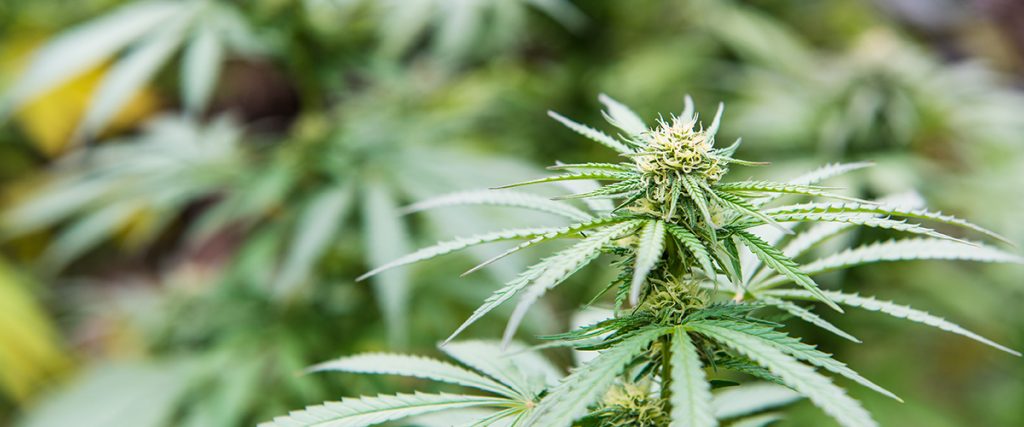
Learn More about Marijuana
With more and more states legalizing marijuana for medical and recreational use, consumers everywhere are looking to learn about marijuana, including how to grow cannabis, how to store marijuana extracts, and how to roll the perfect joint.
You can learn more about marijuana by visiting our Cannabis 101 Page.

